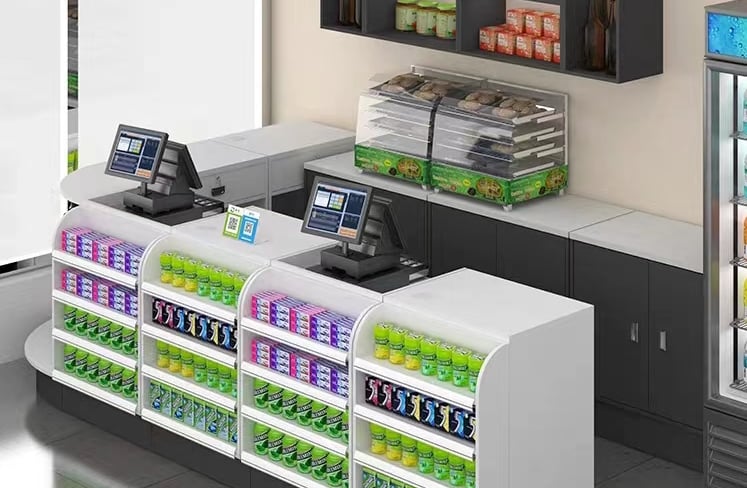The Purpose and Impact of Small Display Racks at Cash Registers in Supermarkets and Stores
8/7/20244 min read


Introduction to Small Display Racks at Cash Registers
Small display racks at cash registers, commonly referred to as 'impulse racks' or 'checkout displays,' play a pivotal role in modern retail environments. Strategically positioned near the point of sale, these display units are designed to capture the attention of shoppers during the final moments of their purchasing journey. The primary function of these small display racks is to encourage impulse buys, leveraging both psychological principles and consumer behavior patterns.
The strategic placement near cash registers ensures that these products are in the direct line of sight of customers as they wait to complete their transactions. This positioning maximizes visibility and convenience, making it effortless for shoppers to add last-minute items to their baskets. The products displayed are often small, low-cost, and highly appealing, such as snacks, candy, batteries, magazines, and seasonal or promotional items.
Psychologically, impulse racks capitalize on the shopper's decision-making process. As customers approach the cash register, their shopping mission is nearly complete, and they may exhibit reduced resistance to unplanned purchases. The theory of 'decision fatigue' suggests that after making numerous purchasing decisions throughout the store, customers are more prone to succumbing to impulse buys. The items on these racks are typically perceived as low-risk due to their minimal cost, further lowering the barrier to purchase.
Moreover, the checkout display leverages the power of suggestion and the human tendency towards indulgence and instant gratification. By offering products that satisfy immediate needs or desires, such as a treat or a practical item for the home, retailers can uplift their sales volumes significantly. This seemingly minor addition to the retail layout can lead to a substantial boost in overall revenue, underscoring the importance of small display racks in commercial settings.
Functions and Benefits of Checkout Displays
Checkout displays serve a pivotal role in the retail environment, functioning as strategic focal points designed to augment sales and enhance the shopper experience. Positioned at high-traffic areas, such as cash registers, these small display racks capitalize on the customer's final moments in-store, prompting impulse buys that can significantly boost overall sales.
One of the primary functions of these checkout displays is to effectively utilize the otherwise underutilized space at the point of sale. By optimizing space in these crucial areas, retailers can showcase a variety of products that might not be purchased during a regular shopping trip. This includes not only everyday essentials but also seasonal items, promotional goods, or newly launched products that can catch the shopper's eye.
Moreover, checkout displays are instrumental in enhancing product visibility. When strategically placed, products on these racks are more likely to garner attention, increasing the likelihood of purchase. This aspect is particularly beneficial for high-margin items, which yield greater profits with each sale. By featuring these profitable products prominently, retailers can drive up their profit margins without necessitating a large increase in inventory.
In addition, these displays play a crucial role in fulfilling immediate customer needs or desires. Items such as snacks, beverages, magazines, and small personal care products are commonly placed on checkout displays, catering to last-minute impulses or forgotten items that customers might need. This tactic not only serves the convenience of the customer but also translates into incremental sales for the retailer.
Furthermore, the strategic placement of these displays can aid in reducing perceived wait times at checkout. When shoppers are engaged by visually appealing product arrangements while waiting in line, their experience feels shorter and more pleasant. This contributes to enhanced customer satisfaction and loyalty, further benefiting the retailer in the long run.
By understanding and employing the above-stated functions and benefits of checkout displays, retailers can not only maximize their utilization of space and product visibility but also tap into additional revenue streams, ultimately enriching the shopping experience and driving overall sales performance.
Types of Products Typically Found on Checkout Displays
Checkout displays, strategically located near cash registers in supermarkets and stores, are prime spots for a diverse array of products. These displays are designed to exploit impulse buying behavior and provide last-minute purchase opportunities to customers. The selection of items placed on these racks reflects a well-thought-out merchandising strategy, catering to various customer needs and preferences.
Everyday essentials frequently grace these checkout displays. Products like gum, candy, and breath mints are common staples, their small size and inexpensive price making them perfect for quick, impulse buys. Additionally, batteries are often placed on these displays due to their necessity and the frequent need for replacements among consumers.
Seasonal items also play a significant role on checkout displays. During holidays or special occasions, retailers stock these racks with themed merchandise such as holiday chocolates, festive decor, and greeting cards. This strategy not only increases seasonal sales but also enhances the shopping experience by keeping it relevant and engaging for customers.
Promotional goods and new product launches find a prominent place on checkout displays as well. Retailers utilize these high-traffic areas to introduce customers to new products and limited-time offers. This exposure often leads to higher trial rates and can significantly boost sales. For instance, a new snack item or a discounted beauty product can swiftly catch the eye of a waiting customer.
The selection process for products to be placed on checkout displays revolves around the concept of fast-moving, small-sized items that appeal to a wide range of customers. Products chosen for these displays are typically those that customers might need but didn't initially plan to buy. Retailers analyze purchasing data and customer behavior to decide which items are likely to perform best in these positions.
